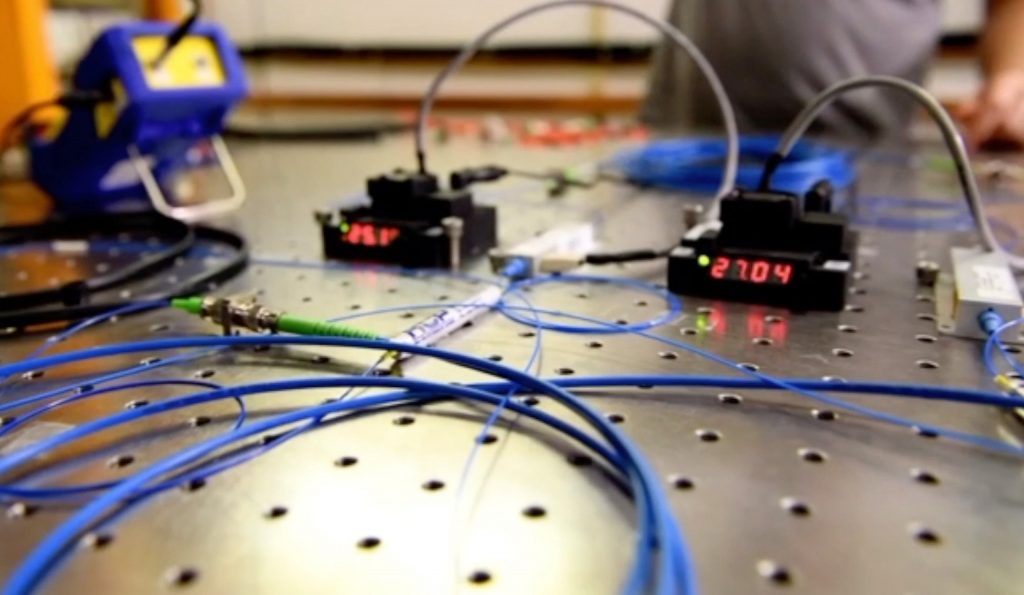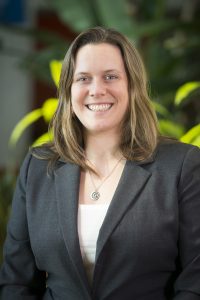A viable quantum internet — a network in which information stored in qubits is shared over long distances through entanglement — would transform the fields of data storage, precision sensing and computing, ushering in a new era of communication.
This month, scientists at Fermilab, a U.S. Department of Energy Office of Science national laboratory, and their partners took a significant step in the direction of realizing a quantum internet.
In a paper published in PRX Quantum, the team presents for the first time a demonstration of a sustained, long-distance (44 kilometers of fiber) teleportation of qubits of photons (quanta of light) with fidelity greater than 90%. The qubits were teleported over a fiber-optic network using state-of-the-art single-photon detectors and off-the-shelf equipment.
“We’re thrilled by these results,” said Fermilab scientist Panagiotis Spentzouris, head of the Fermilab quantum science program and one of the paper’s co-authors. “This is a key achievement on the way to building a technology that will redefine how we conduct global communication.”

In a demonstration of high-fidelity quantum teleportation at the Fermilab Quantum Network, fiber-optic cables connect off-the-shelf devices (shown above), as well as state-of-the-art R&D devices. Photo: Fermilab
Quantum teleportation is a “disembodied” transfer of quantum states from one location to another. The quantum teleportation of a qubit is achieved using quantum entanglement, in which two or more particles are inextricably linked to each other. If an entangled pair of particles is shared between two separate locations, no matter the distance between them, the encoded information is teleported.
The joint team — researchers at Fermilab, AT&T, Caltech, Harvard University, NASA Jet Propulsion Laboratory and University of Calgary — successfully teleported qubits on two systems: the Caltech Quantum Network, or CQNET, and the Fermilab Quantum Network, or FQNET. The systems were designed, built, commissioned and deployed by Caltech’s public-private research program on Intelligent Quantum Networks and Technologies, or IN-Q-NET.
“We are very proud to have achieved this milestone on sustainable, high-performing and scalable quantum teleportation systems,” said Maria Spiropulu, Shang-Yi Ch’en professor of physics at Caltech and director of the IN-Q-NET research program. “The results will be further improved with system upgrades we are expecting to complete by Q2 2021.”
CQNET and FQNET, which feature near-autonomous data processing, are compatible both with existing telecommunication infrastructure and with emerging quantum processing and storage devices. Researchers are using them to improve the fidelity and rate of entanglement distribution, with an emphasis on complex quantum communication protocols and fundamental science.
The achievement comes just a few months after the U.S. Department of Energy unveiled its blueprint for a national quantum internet at a press conference in Chicago.
“With this demonstration we’re beginning to lay the foundation for the construction of a Chicago-area metropolitan quantum network,” Spentzouris said. The Chicagoland network, called the Illinois Express Quantum Network, is being designed by Fermilab in collaboration with Argonne National Laboratory, Caltech, Northwestern University and industry partners.
This research was supported by DOE’s Office of Science through the Quantum Information Science-Enabled Discovery (QuantISED) program.
“The feat is a testament to success of collaboration across disciplines and institutions, which drives so much of what we accomplish in science,” said Fermilab Deputy Director of Research Joe Lykken. “I commend the IN-Q-NET team and our partners in academia and industry on this first-of-its-kind achievement in quantum teleportation.”
Fermilab is America’s premier national laboratory for particle physics and accelerator research. A U.S. Department of Energy Office of Science laboratory, Fermilab is located near Chicago, Illinois, and operated under contract by the Fermi Research Alliance LLC, a joint partnership between the University of Chicago and the Universities Research Association, Inc. Visit Fermilab’s website at www.fnal.gov and follow us on Twitter at @Fermilab.
The Office of Science is the single largest supporter of basic research in the physical sciences in the United States and is working to address some of the most pressing challenges of our time. For more information, visit science.energy.gov.

Since March 2020, Kate Sienkiewicz has led the team designing and building the facilities that will hold the scientific equipment at the Near Site of the Deep Underground Neutrino Experiment. Photo: Al Johnson, Fermilab
How long have you been at Fermilab?
About seven-and-a-half years.
How did you end up working at Fermilab?
I was a materials science and engineering undergrad major. After that, I went into the CIA in Washington, D.C., because I thought it would be cool and unique, and I always liked watching spy movies. I took an oath to defend the Constitution of the United States when I was 21 years old, and my work contributed to protecting our national security. I was in D.C. and traveled internationally for about nine years doing a variety of high-tech projects and cutting-edge research and development. I’m from Chicago, though, so I got to a point where I wanted to come home and be near family again. Then I got my master’s in environmental engineering, and that’s what brought me to Fermilab.
Initially I did a lot of surface water management efforts here as part of the Facilities Engineering Services Section. Later, I was the first project manager for the Integrated Engineering Research Center. That’s the new building that’s recently started construction out front of Wilson Hall.
What is your current role at the laboratory?
I oversee the Long-Baseline Neutrino Facility Near Site Conventional Facilities team. LBNF is the infrastructure that supports the international Deep Underground Neutrino Experiment, which Fermilab is hosting. We’re designing and constructing the facilities that all the scientific equipment goes inside of. We’re building the buildings, providing power and water, making sure we have the right amount of shielding, all of that stuff.
What challenges have you encountered in that process?
We need a lot of coordination and discussions with stakeholders across the laboratory, from different divisions and sections, to identify requirements and clarify details at the level required for the design. Building relationships and open communication is key to making sure we capture the right information as early in the design process as possible — discovering new requirements during construction is too late and potentially results in higher costs or delays.
Also, we need to make sure that the scientists are able to move their detector down a 38-foot-diameter shaft to a cavern 200 feet underground. Then, they need to have enough room to assemble it down there.
What is the most rewarding part of your work?
I find that in my career I like big, complicated projects that are trying to solve a unique problem and make a difference somehow. What I like about Fermilab and my project is that there are complex problems that need to be solved, and I get to work with the scientists to determine what they need and make sure that we deliver on that. All the time, I’m working toward the main goal, which is to solve the mysteries of the universe. Not a lot of people get to say that, and so I think that’s really neat.
Another thing I like about my job is my co-workers and the project atmosphere. We’re all pushing toward one goal together, so I like the camaraderie and the teamwork.
What do you like to do when you are not at work?
I have a dog. I love her, and she’s great. We go for dog walks and go to the dog park. Also, I like to ski and hike, and I enjoy hanging out with friends trying new restaurants or breweries.
The Long-Baseline Neutrino Facility is supported by the Department of Energy Office of Science.
The Office of Science is the single largest supporter of basic research in the physical sciences in the United States and is working to address some of the most pressing challenges of our time. For more information, visit science.energy.gov.
On Dec. 10, the Italian magazine D La Repubblica named Anna Grassellino, scientist at the U.S. Department of Energy’s Fermi National Accelerator Laboratory, as “Woman of the Year.” Grassellino was selected from a list of 50 excellent Italian women in different fields who left an impression on 2020. She is the director of the new Superconducting Quantum Materials and Systems Center based at Fermilab. The SQMS Center has the ambitious goal of building and deploying a beyond-state-of-the-art quantum computer over the next five years as part of an international collaborative effort involving 20 partner institutions including the Italian National Institute of Nuclear Physics (INFN).
“I’m so honored to be named Woman of the Year 2020 by D La Repubblica,” Grassellino said. “2020 is the year that has brought more awareness in the world of the crucial importance of science as a beacon of hope for the future of our society. I hope to be a true testimonial of the importance of investing in science and innovation and to be of inspiration for all the young girls and women who aspire to have a career in STEM. My message to them is ‘yes you can,’ and that science is driven by creativity and thrives on diversity.”
Grassellino is from Marsala, Italy, and studied electronic engineering at the University of Pisa. She received her doctorate from the University of Pennsylvania before joining Fermilab in 2012. Her specialty is superconducting radio-frequency technology, known as SRF, the heart of modern particle accelerators. She has received several awards for the discovery of nitrogen doping, a technique that dramatically increases the efficiency of SRF cavities.
Superconducting technology is also a unique feature of the SQMS Center, one of five DOE quantum centers established earlier this year in the United States. One of the core questions SQMS research will tackle is how to extend the lifetime of qubits, the building blocks of quantum computers. The SRF cavities originally developed for particle accelerators have already successfully expanded into the quantum computing realm, showing success in extending qubit lifetimes.
In addition, the SQMS Center will develop new quantum sensors, which could lead to the discovery of the nature of dark matter and other elusive subatomic particles. Progress in quantum computing could lead to revolutions in particle physics and in other fields as well, including biology, medicine, energy, finance and national security.
“Anna Grassellino is a brilliant and tireless researcher who has had an impact on particle accelerator technology beyond anything imagined a few years ago,” said Fermilab Director Nigel Lockyer. “She has now turned her talents and focus to leading a national DOE quantum information science center collaborating with leading Italian researchers, along with numerous key academic and industry contributors. Fermilab is very proud of her accomplishments and leadership.”
While the SQMS Center is hosted at Fermilab, it brings together world-class experts from partners including Northwestern University, Ames Laboratory, the National Institute of Standards and Technology, Rigetti Computing and INFN, which has collaborated with Fermilab for more than 40 years.
Quantum information science and particle accelerator research is supported by the Office of Science of the U.S. Department of Energy.
Learn more about the partnerships and goals of the Superconducting Quantum Materials and Systems Center.
The Office of Science is the single largest supporter of basic research in the physical sciences in the United States and is working to address some of the most pressing challenges of our time. For more information, please visit energy.gov/science.

